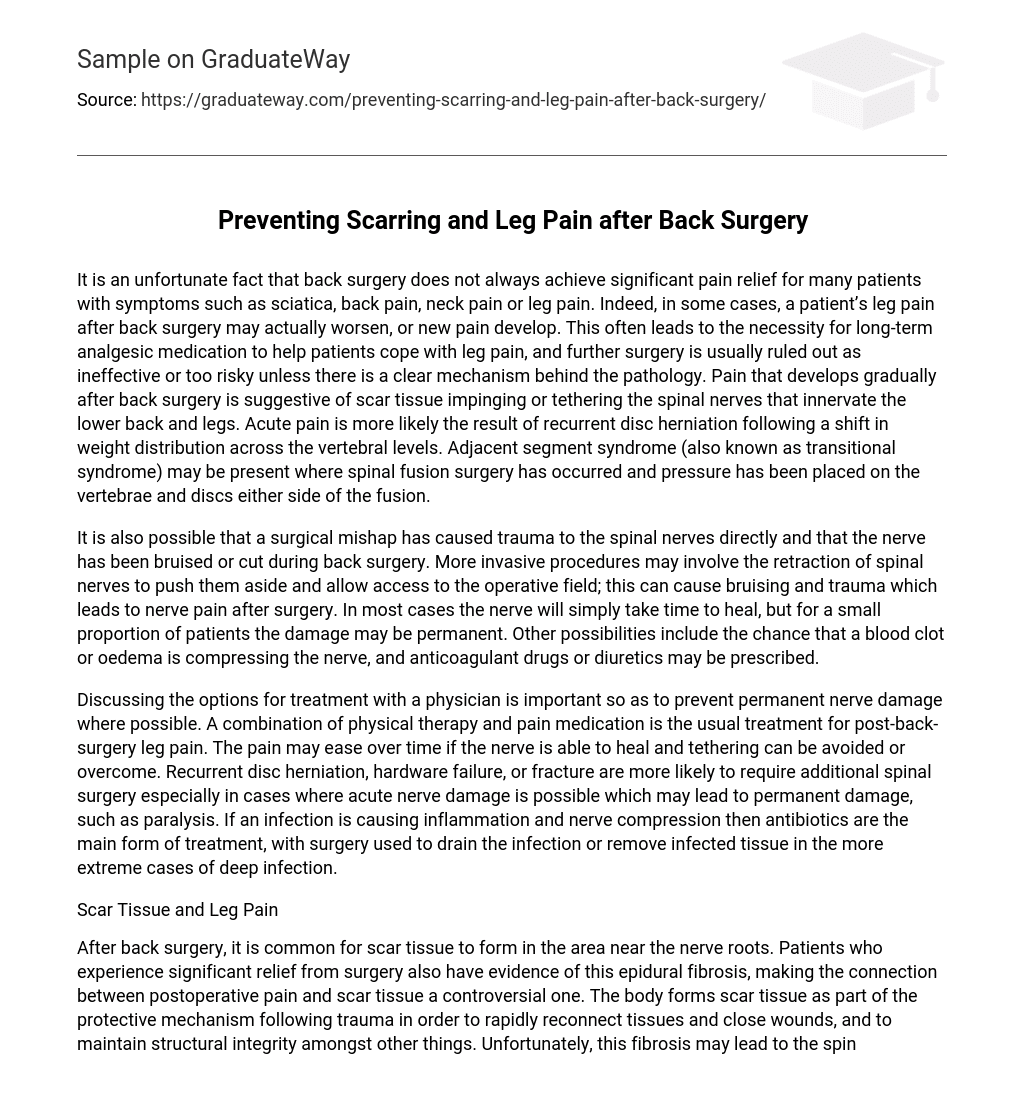It is an unfortunate fact that back surgery does not always achieve significant pain relief for many patients with symptoms such as sciatica, back pain, neck pain or leg pain. Indeed, in some cases, a patient’s leg pain after back surgery may actually worsen, or new pain develop. This often leads to the necessity for long-term analgesic medication to help patients cope with leg pain, and further surgery is usually ruled out as ineffective or too risky unless there is a clear mechanism behind the pathology. Pain that develops gradually after back surgery is suggestive of scar tissue impinging or tethering the spinal nerves that innervate the lower back and legs. Acute pain is more likely the result of recurrent disc herniation following a shift in weight distribution across the vertebral levels. Adjacent segment syndrome (also known as transitional syndrome) may be present where spinal fusion surgery has occurred and pressure has been placed on the vertebrae and discs either side of the fusion.
It is also possible that a surgical mishap has caused trauma to the spinal nerves directly and that the nerve has been bruised or cut during back surgery. More invasive procedures may involve the retraction of spinal nerves to push them aside and allow access to the operative field; this can cause bruising and trauma which leads to nerve pain after surgery. In most cases the nerve will simply take time to heal, but for a small proportion of patients the damage may be permanent. Other possibilities include the chance that a blood clot or oedema is compressing the nerve, and anticoagulant drugs or diuretics may be prescribed.
Discussing the options for treatment with a physician is important so as to prevent permanent nerve damage where possible. A combination of physical therapy and pain medication is the usual treatment for post-back-surgery leg pain. The pain may ease over time if the nerve is able to heal and tethering can be avoided or overcome. Recurrent disc herniation, hardware failure, or fracture are more likely to require additional spinal surgery especially in cases where acute nerve damage is possible which may lead to permanent damage, such as paralysis. If an infection is causing inflammation and nerve compression then antibiotics are the main form of treatment, with surgery used to drain the infection or remove infected tissue in the more extreme cases of deep infection.
Scar Tissue and Leg Pain
After back surgery, it is common for scar tissue to form in the area near the nerve roots. Patients who experience significant relief from surgery also have evidence of this epidural fibrosis, making the connection between postoperative pain and scar tissue a controversial one. The body forms scar tissue as part of the protective mechanism following trauma in order to rapidly reconnect tissues and close wounds, and to maintain structural integrity amongst other things. Unfortunately, this fibrosis may lead to the spinal nerve(s) becoming tethered or compressed by adhesions which can cause leg pain after surgery. The scar tissue itself contains no nerve endings, with the leg pain principally stemming from the compression of the nerve root by fibrous adhesions.
If a patient is in good health, is of an optimum weight, does not smoke, drink heavily, or attempt to fast-track their recovery then scarring should not cause too much of a problem after back surgery. Of course, it is perfectly possible that a patient adheres to all surgical guidelines and still suffers from epidural fibrosis and resultant leg pain, but the probability is less likely. Techniques are available to surgeons to limit the degree of epidural fibrosis, but they remain largely untested (except in animals). Fat grafts, gelatin sponges, and sheets of silicon-based interpositional membrane can all limit the potential for adhesions to occur around the nerve root but their use is, currently, limited.
It is important to remain active to prevent leg pain after back surgery in order to keep the nerves mobile and prevent them becoming tethered by scar tissue. Conversely, by engaging in vigorous physical activity too quickly after back surgery, a patient may inadvertently trigger an inflammatory response in the body and worsen scarring, leading to leg pain and back pain, or even surgical hardware failure. A common exercise encouraged after back surgery to prevent the nerve becoming tethered by scarring is where a patient pumps their ankle up and down whilst stretching their hamstring. This motion moves the nerve across the site of surgery near the disc space and can stop fibrous adhesions from growing across, and compressing, the nerve.
Symptoms of Epidural Fibrosis
Back surgery takes many different forms and some operations, such as laminectomy, take considerably longer to heal from than others, such as the X-Stop procedure. If epidural fibrosis occurs during this recovery period then the symptoms are usually slow to develop, with a gradual increase in pain or discomfort over the initial six to twelve weeks after back surgery. Patients often experience a degree of pain relief initially as the compression on the nerve roots is relieved by decompressive back surgery, but the pain may return, or new pain develop afterwards.
For some patients the relief may occur after a few weeks as the decompressed nerve begins healing, only to be followed shortly after by recurrent leg pain as the scarring takes hold. The larger the extent of nerve damage prior to back surgery, the longer the recovery is likely to take, and the less successful the surgery is likely to be. A common test for epidural fibrosis that the patient may undergo in their physician’s office is the straight-leg test, where scarring is usually suspected if they experience pain on lifting the leg when straight. Repeat decompression, or discectomy, is likely to be effective for such patients.





